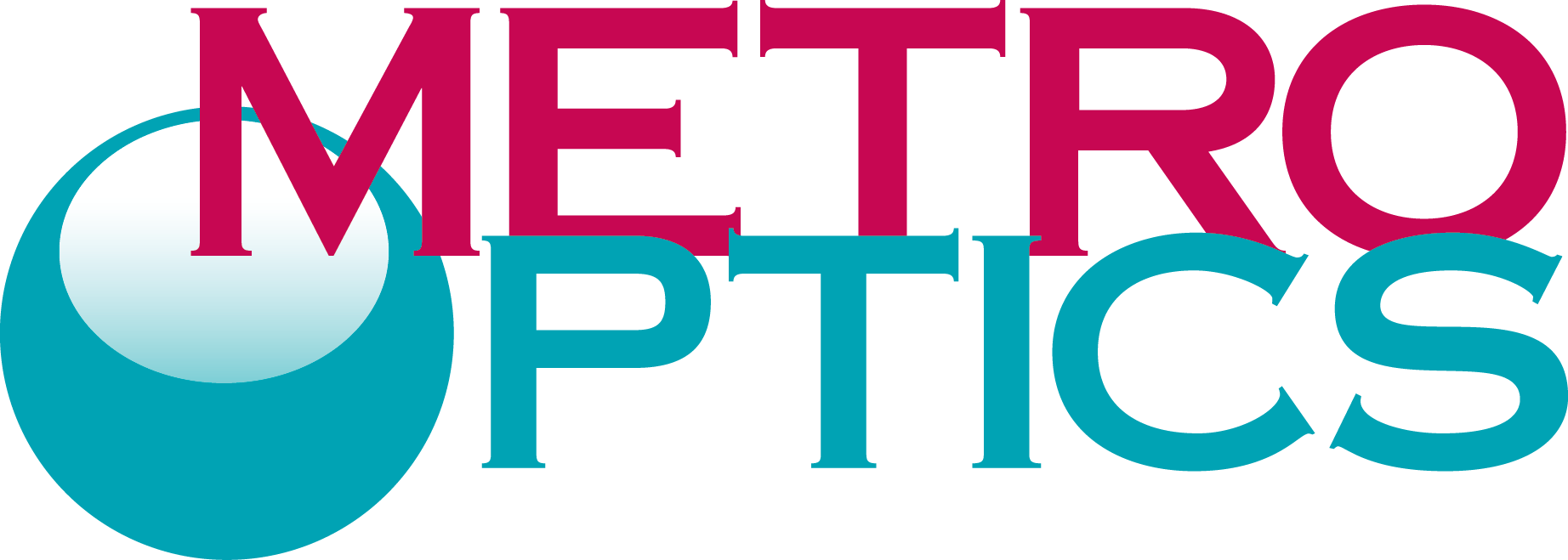Frequently Asked Questions

Optometrist: Steven Chau, Jr., O.D.
Practice: Vision Republic, Katy, Texas
Patient: 31 YO Female
Condition: Myopia OU with GPC
Presentation:
Patient works in a lab setting where she has wears a face mask and goggles, causing her glasses to fog up. She is also prohibited from wearing soft contact lenses in the lab. She is looking for an alternative to wearing contact lenses at work and has expressed interest in Ortho-K as a solution to meet her visual needs in her career.
Ocular History:
She has tried both monthly and daily contact lenses in the past but experienced issues with GPC. As a result, corneal GP lenses were not a suitable option for her either.
Prescribed lenses:
Metro K lens in Boston XO material. Managing her GPC has been a top priority over the past 16 months to maintain comfort and VA.
OD: -3.50 -0.75 x 171
OS: – 3.75 -1.00 x 016
Outcome:
Patient wears her Ortho-K lenses for 8 hours each night and remains uncorrected during the day.
BCVA: 20/20 OU
Help More Patients in Your Area:
Find Vision Republic on our Physician Locator page as a specialty contact lens practice. Is your practice on the map? Check here.
Maximum Astigmatism
MetroSoft Max stands for “maximum astigmatism,” ideal for your patients whose visual needs can’t be met with glasses or standard daily contact lenses.
Lens Parameters
The MetroSoft Max can correct up to 8.00D of astigmatism, and we deliver the lenses to you in about a week.
Base curve: 8.1 to 8.9 depending on material
Power: -12.00 to +12.00
Diameter: 14.0, 14.2 depending on lens design
Prism: 1 Diopter
Extended parameters are available.
Ideal Patient
Any astigmatic case with up to 8.00 diopters of corneal cylinder.
Stable Vision
The Metro Soft Max is indicated for patients with 2.00D or more of corneal astigmatism. The cylinder correction is incorporated into the back surface of the lens, which aligns with the irregular curvature of the cornea.
This results in a “saddle-fit,” which stabilizes the lens on the cornea, improving comfort and VA compared to a spherical contact lens.
Latheable Materials
Our soft contact lens line is available in three materials, listed below. Our consultants will work with you to determine the best material for your patient, with ocular surface health as our top priority.
- Polymacon: 38% water standard hydrogel
- Hioxyfilcon-B: 49% water standard hydrogel
- Definitive SiHy Efrofilcon-A: 74% water, 60 Dk (first latheable Silicone Hydrogel Material)
Learn More
Replacement schedule
Planned replacement is at the discretion of the doctor. The life of the lens will depend on how well the patient cares for the lenses. Multi-packs are available up to annual supply.
Log-In or Register your free account to the Physician Portal to access multi-pack details.
Education
“You can wear contacts!” We’re here to help you educate your patients about all of their contact lens options.
CONSULTATION: 800-223-1858
EMAIL: info@metro-optics.com

Optometrist: Beth Robinson, O.D.
Practice: See B. Seen Eyecare + Optical Bar, Friendswood, Texas
Patient: 12 YO Female
Condition: Myopia OU
Presentation:
Patient presents with mild myopia OU wearing soft daily contact lenses. She reports slight changes in distance vision with daily soft contact lenses prescribed six months prior.
Ocular History:
Manifest refraction upon examination is OD -1.50 -050 x 090 and OS -2.00 -0.25 x 063. Her current daily contact lenses are -1.50 DS and -2.00, OD and OS respectively. She prefers an
over-refraction of -0.25 each eye revealing possible progression in myopia over a six-month period.
Prescribed lenses:
Metro K lens in Boston XO material.
Base Curve Power Diameter Reverse Curve
OD 8.18 +0.75 10.60 7.30
OS 8.23 +0.75 10.60 7.30
Outcome:
Patient wears Ortho-K lenses most nights for 8 hours on average and remains uncorrected during the day.
Resulting vision: OD VA 20/20, OS VA 20/20
Manifest Refraction: OD plano, OS plano
The patient loves her new form of vision using the new lenses while also managing any myopic progression.
Help More Patients in Your Area:
Find the See B. Seen Eyecare + Optical Bar on our Physician Locator page as a specialty contact lens practice. Is your practice on the map? Check here.
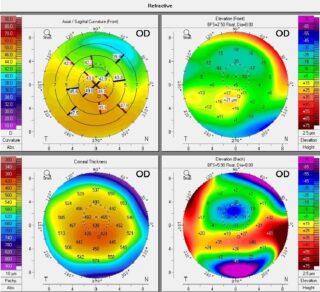
Practice: Illinois College of Optometry
Patient: 52 YO Female
Condition: Keratoconus, s/p intacs OD
Presentation:
Patient was diagnosed with keratoconus over 20 years prior. She had intacs and corneal cross linking OD. Her goal was to stay in soft contact lenses if possible.
Ocular History:
Keratoconus, intacs, corneal cross linking, ocular allergies
Prescribed Lenses:
Kerasoft IC STD
Learn more
Outcome:
20/20 OD
20/20-1 OS
Patient reports great vision and comfort all waking hours of day. She spends 8-10 hours per day on the computer and has no difficulties with lens wear.
Help More Patients in Your Area:
Find the Illinois College of Optometry on our Physician Locator page as a specialty contact lens practice. Is your practice on the map? Check here.
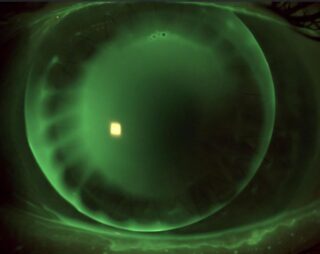
Practice: Illinois College of Optometry
Patient: 86 YO Female
Condition: Keratoconus, s/p PKP OS
Presentation:
Patient has a history of long term corneal GP wear for keratoconus. She presented for new corneal GPs after undergoing cataract surgery and a corneal transplant OS.
Ocular History:
Keratoconus, cataract surgery OD, cataract surgery OS, dry eye disease, allergic conjunctivitis, s/p PKP OS.
Prescribed Lenses:
RSB OS
The RSb Lens is our post-refractive surgery lens, reverse geometry configuration.
Learn more
Outcome:
Patient was 20/200 with her glasses and with the RSB lens, her VA improved to 20/25+. She is thrilled with her VA and improvement in quality of VA.
Help More Patients in Your Area:
Find the Illinois College of Optometry on our Physician Locator page as a specialty contact lens practice. Is your practice on the map? Check here.

Optometrist: Shelby Gross, OD
Practice: Heights Vision Specialists
Patient: 78 YO Male
Condition: Post LASIK & Cataract
Presentation:
OD: -4.00 -2.50 x 090
OS: – 0.75 -0.75 x 045
Patient doesn’t want to wear glasses, “Anything but Glasses.” Conventional lenses aren’t working for him. He has difficulty seeing his lenses and ends up poking his eye when trying to insert them.
Ocular History:
LASIK and cataract surgery OU. Patient had a retina detachment with a scleral buckle in his right eye. Severe dry eye.
Prescribed Lenses:
RSb front toric lens OD for monovision. Dr. Gross started him on a therapeutic regimen to optimize the ocular surface.We selected a well tinted corneal GP to assist in handling the lens during insertion.
OD: -4.00 -3.50 x 090
The RSb Lens is our post-refractive surgery lens, reverse geometry configuration.
Learn more
Outcome: BCVA 20/20
He is very happy with the outcome.
Help More Patients in Your Area:
Find Heights Vision Specialists on our Physician Locator page as a specialty contact lens practice. Is your practice on the map? Check here.
Simple & Straightforward
Fitting corneal GPs is easier than you think. Getting started is easy – no diagnostic fit set is required for most Metro Optics GP lens designs.
Note: Keratoconus can be fit empirically, but chair time is reduced by using a diagnostic set. We offer a complimentary ComfortKone Quick Fit Set. Learn more here.
Order GP lenses empirically, without any lens design calculations. Simply send the following patient information to consultation.
Exam Information
- Corneal Topography
- Keratometry Readings (Auto-K works well)
- Manifest Refraction
- Pertinent Patient History (surgery, trauma, past contact lens wear)
This information helps us understand the corneal shape & curvatures we are attempting to fit. If you don’t have a topographer, that’s okay!
GP Lens Designs
All major brand materials are available including Hyper Dk materials.
- Standard Spherical GP
Less than 3.00D Astigmatism - Specialty GP Designs
Toric lens options: base, front surface, bi-toric designs - Metro Progressive Multifocal GP
Presbyopic patients
Up to 3.00D ADD
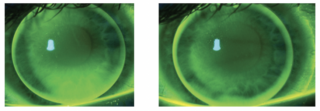
Spherical Lens on Left & Toric Lens on the Right
4. MetroSeg Translating Bifocal GP
Segmented Bifocal
Up to 3.00D ADD
5. RSa or RSb Post – Surgical GP
Post-surgical lens
Vaults central corneal irregularity
RS stands for Refractive Surgery
RSa: Spherical configuration
RSb: Reverse geometry configuration
Hydra-PEG
You have the option to Hydra PEG the lens which is a 90% water PEG (polyethylene glycol) coating that is covalently bonded to the surface of the lens. Hydra PEG improves wettability, comfort and clarity.
Learn more
Do What You Can
If you don’t have all the information listed above, don’t worry! Our experienced consultants can design a lens based on the details you provide. The more accurate information we receive, the faster we can get the final lens to you.
We are here to support you every step of the way!
Sincerely,
Your Metro-Optics Team
CONSULTATION: 800-223-1858
EMAIL: info@metro-optics.com
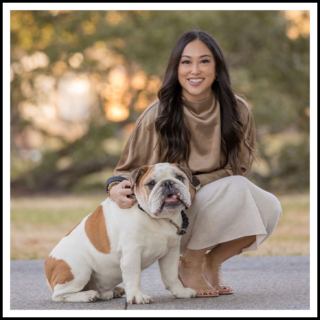
Optometrist: Dr. Katherine Tran, O.D.
Practice: Eye Society, Houston, TX
Patient: 30 YO Female
Condition: Severe Dry Eye Disease
Presentation:
Patient presented with extreme dry eye and was previously advised against wearing contacts. She expressed a preference for contacts over glasses.
Ocular History:
The patient is a high myope with bilateral astigmatism. She can only count fingers without correction.
OS: -6.00 -1.00 x 031
OD: -6.25 -0.75 x 145
Vision: 20/400 OU
Prescribed lenses:
Standard GP Sphere in Optimum Infinite Blue, a hyper-Dk material, delivering 180 Dk, with Hydra-PEG surface treatment to optimize wettability and comfort.
Learn more here
Outcome:
OU BCVA: 20/20
The patient loved the lenses immediately! She was thrilled to experience clear vision and was excited that she could wear contacts. She comfortably wears her contacts for 10 hours a day, & her dry eye symptoms have improved.
Help More Patients in Your Area:
Find Eye Society on our Physician Locator page as a specialty contact lens practice. Is your practice on the map? Check here.
What Information Do You need to order an InSight Scleral Lens?
Our methodology focuses on simplicity and optimizing your chair time. Provide us with your observations, and we’ll handle the lens parameters.
If you can place a diagnostic lens on the eye with sodium fluorescein (NaFl), note your observations, we can deliver an initial lens within a few days.
Corneal and scleral GP lenses typically take 2–3 days to manufacture; Hydra-PEG adds one day to the process. Standard shipping is 2-3 business days.
Checklist for Simplified Ordering:
1. Initial Lens Selection
Based Selection on Sagittal Height
This reflects the overall curvature of the cornea.
- Steep/Ectatic Corneas: Start with the Prolate 5.000 SAG
- Flatter/Oblate Corneas: Select the Oblate 4.750 SAG
2. Evaluation (Three Steps)
- Central Clearance:
Aim for ~250 microns of clearance, represented by a 1:1 ratio—250 microns of post-lens tear film and 250 microns of lens center thickness. - Peripheral Clearance:
Ensure NaFl clears the limbus 360° with 50–80 microns of peripheral clearance. Look for any areas of bearing or blanching; the limbus should always be vaulted. - Edge Alignment:
The lens should sit comfortably on the conjunctiva. Check for signs of impingement or blood vessel constriction.Please send images or short 2-3 second videos of the lens on the eye.
Quick Tip:
After lens removal, check for staining and report it to consultation if present.
3. Patient Feedback
Ask the patient how the lens feels:
- Lens Awareness: If the patient feels the lens, it’s likely a landing issue.
- Discomfort: If the lens is uncomfortable, remove it immediately. Scleral lenses should be very comfortable.
4. Topography:
Provide topographical data for consultation—it gives a clearer picture for customized lens fitting.
5. Anterior Segment OCT (Optional):
If available, AS-OCT images offer additional data to help understand what is happening with the lens on the eye, though it is not required.
6. HVID (Horizontal Visible Iris Diameter):
This measurement is essential for incorporating multi-focal optics, optimizing visual acuity and customizing the lens to the patient’s lifestyle.
7. Sphere-Cylinder Over-Refraction:
The SCOR provides the most accurate visual acuity and avoids inducing astigmatism. The InSight Scleral Lens can incorporate up to +3.00 D of ADD power.
8. Pertinent Patient Information:
Provide details such as:
- Previous contact lens wear
- Surgical procedures
- Visual demands
- Any factors that could significantly impact the lens design
9. Hydra-PEG (Optional):
Ask during consultation if Hydra-PEG is suitable for the patient.
Hydra-PEG Benefits:
- Improves wettability by lowering the wetting angle
- Reduces deposits and fogging
Please call consultation with the above information to discuss further, and we will have the lenses to you in a few short days.
If you don’t have all the information listed above, don’t worry! Our experienced consultants can design a lens based on the details you provide. The more accurate information we receive, the faster we can get the final lens to you.
We are here to support you every step of the way!
Sincerely,
Your Metro-Optics Team
CONSULTATION: 800-223-1858
EMAIL: info@metro-optics.com
All rights reserved. | Quality Terms & Conditions
